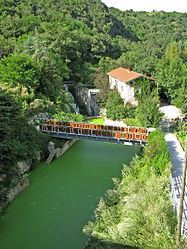Time zone CET (UTC+1) Area 3.91 km² | INSEE/Postal code 42307 /42800 Population 596 (1999) | |
 | ||
Tartaras is a commune in the Loire department in central France. It is in the Gier valley just north of the river, between Rive-de-Gier to the west and Saint-Romain-en-Gier to the east.
Contents
Map of 42800 Tartaras, France
History
The village dates back to the Roman era. Gallo-Roman sarcophagi are still visible in the town. During the 19th century Tartarus was in the heart of a coal basin.
Sites
The maison familiale rurale de Tartaras (Tartarus rural family home) is an institution recognized by the Ministry of Agriculture that offers training schemes in the 4th of the professional baccalaureate: horticulture and landscape works.
The Givors canal, built in 1761-81, passed by the village. At coordinates 45.550114°N 4.673738°E / 45.550114; 4.673738 in Tartaras a tunnel 100 metres (330 ft) long and 5 metres (16 ft) wide was broken through solid rock. The tunnel and double lock at its entrance have been preserved as a monument, although the canal has mostly been filled in.
Notable people
Charles Bossut (1730-1814) was born in Tartarus. He was a geometer, mathematician, member of the French Academy of Sciences (elected in 1768), corresponding member of the Academy of Berlin and Adademy of Bologna, honorary member of the Academy of St. Petersburg (1778), a collaborator with Denis Diderot for the mathematical part of the Encyclopedia, the father of the experimental hydrodynamics. Member, with Condorcet and the Abbé Rochon, of the commission of feasibility of canal.
